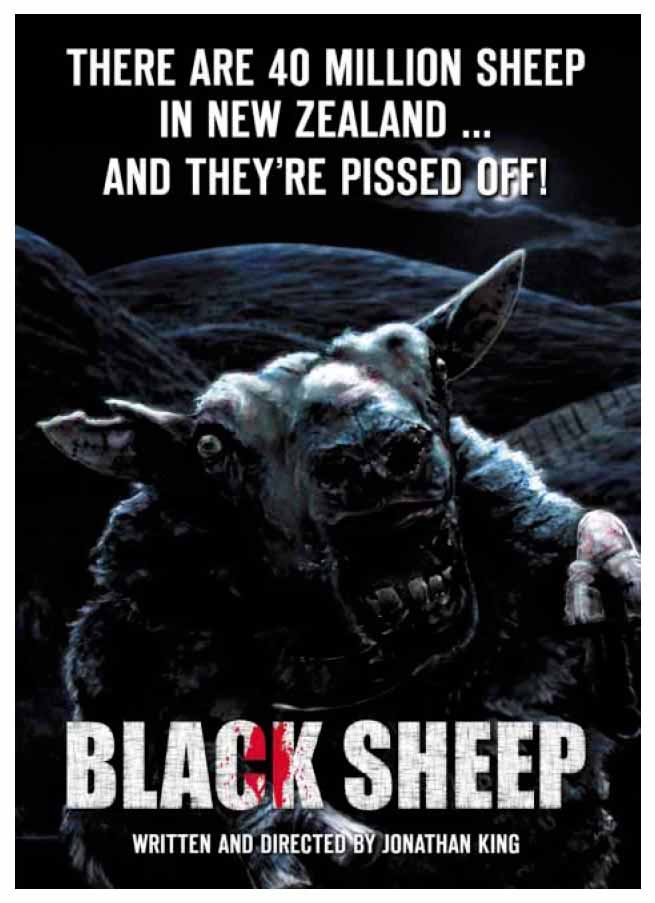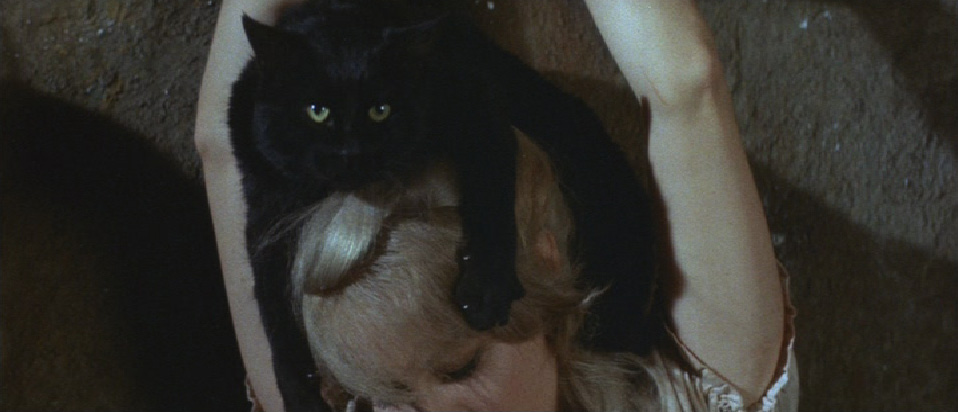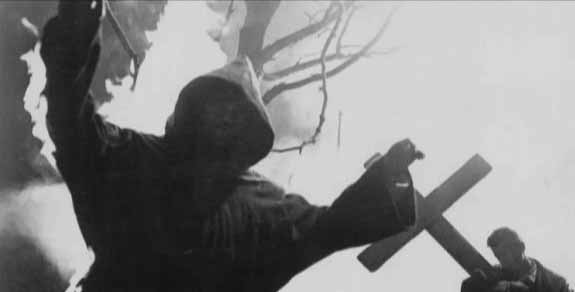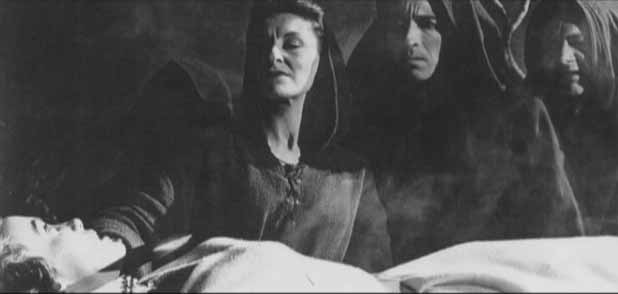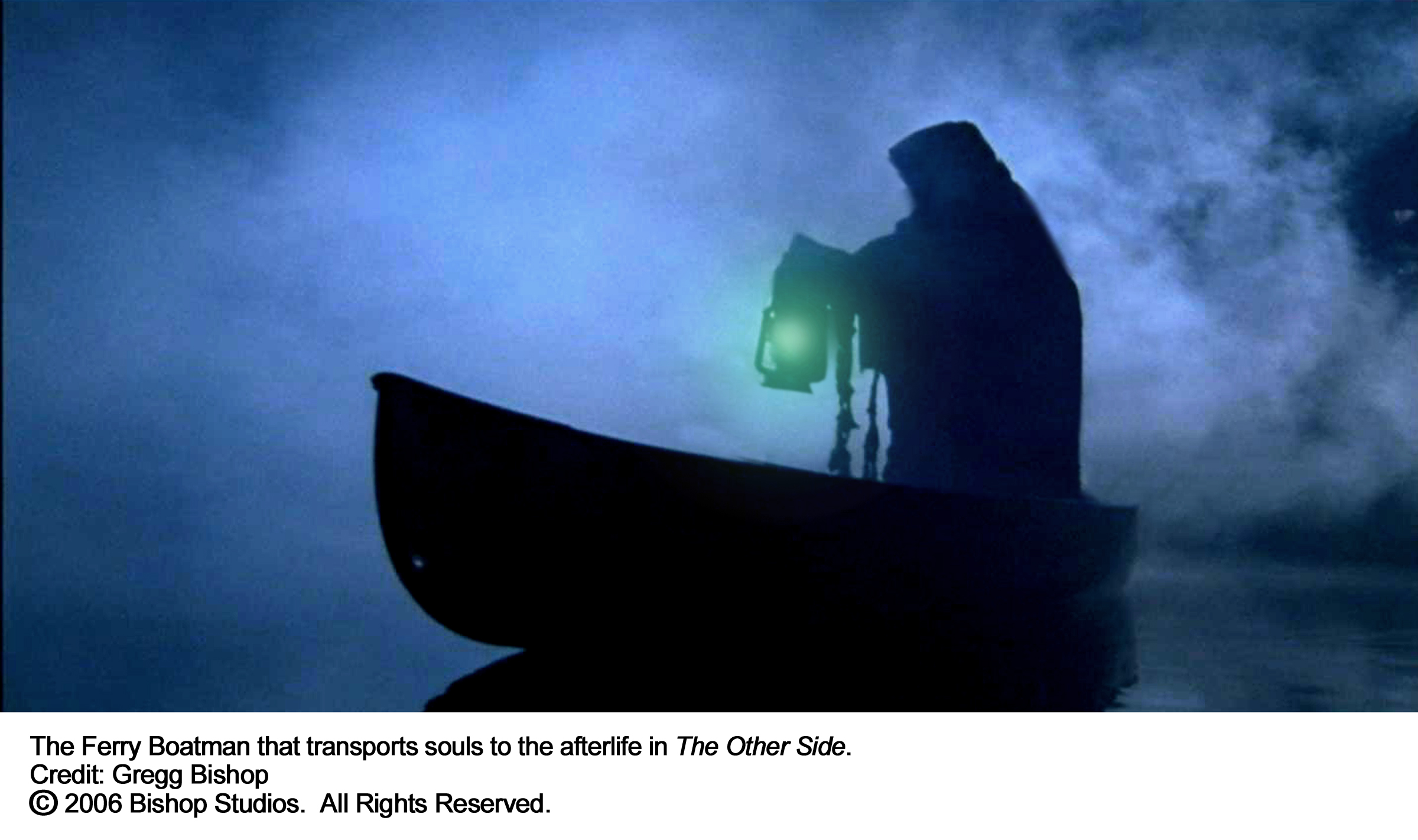 This is a fairly feeble attempt to create an old-fashioned horror anthology, in the manner of TALES FROM THE HOOD, featuring three short stories – set in the hood, naturally – linked together by rapper Snoop Dogg. Unfortunately, the film gets off to an extremely slow start with an animated sequence that sets up the mythology: a gang-banger is turned into an angel-or-demon, one among many who keep an eye out on those who take the wrong path in life. The animation consists mostly of static figures sitting in cars, with blurry backgrounds moving behind them to suggest speed, and the character design bears little if any resemblance to Snoop Dogg. Continue reading “Snoop Dogg's Hood of Horror (2006) – Film Review”
This is a fairly feeble attempt to create an old-fashioned horror anthology, in the manner of TALES FROM THE HOOD, featuring three short stories – set in the hood, naturally – linked together by rapper Snoop Dogg. Unfortunately, the film gets off to an extremely slow start with an animated sequence that sets up the mythology: a gang-banger is turned into an angel-or-demon, one among many who keep an eye out on those who take the wrong path in life. The animation consists mostly of static figures sitting in cars, with blurry backgrounds moving behind them to suggest speed, and the character design bears little if any resemblance to Snoop Dogg. Continue reading “Snoop Dogg's Hood of Horror (2006) – Film Review”
Tag: horror
HATCHET: Interview with writer-director Adam Green
HATCHET is a rare achievement: an homage that exceeds the originals. Inspired by ’80s slasher icons like Michael Myers and Jason Voorhees., writer-director Adam Green has fashioned an atmospheric, fun-filled horror thrill-ride that delivers the gore, along with clever characterization and doses of humor that make the film funny and scary, not just an exercise in spilling entrails.

Anchor Bay Entertainment releases the film in limited engagements nationwide on Friday, September 7; unfortunately, unlike the HALLOWEEN remake (which is in over 3,000 theatres), HATCHET will screen in only a couple dozen cities around the country. (You can find a partial list here, but check your local listings to be sure.) Even this small exposure is quite an achievement when you consider that the film was a labor of love, produced independently because it did not fit the current Hollywood formula. Below the fold, you will find our interview with Green, who describes the long and winding road he took to get his “old school horror” film onto the big screen
Continue reading “HATCHET: Interview with writer-director Adam Green”
Burton sneaks Sweeney
 At the Venice Film Festival, where he received a Golden Lion for lifetime achievement, director Tim Burton unveiled an eight-minute sneak of SWEENEY TODD. Variety’s Nick Vivarelli liked what he saw:
At the Venice Film Festival, where he received a Golden Lion for lifetime achievement, director Tim Burton unveiled an eight-minute sneak of SWEENEY TODD. Variety’s Nick Vivarelli liked what he saw:
The clips, in sharp desaturated color, consisted largely of a key scene in the Stephen Sondheim musical in which Todd, played by Johnny Depp, is handed a razor case by Mrs. Lovett, played by Helena Bonham Carter.
Singing “My Friends” Depp proved he can carry a tune, dueting delightfully with Bonham Carter, herself debuting as a chantoosie.
A white streak in his hair, a mad twinkle in his eye, Depp — in his sixth Burton pic — seemed in fine form in the quick sneak, which, while entertainingly eerie, displayed no violence. Pic is reportedly headed for an “R” rating.
“I am just trying to make an old-fashioned horror movie with music in it,” Burton said at the presser.
He added that pics with “people like Boris Karloff and Peter Lorre” are among vintage scary works he drew on for inspiration.
“It’s quite uncharted territory. I don’t think there are that many horror movie musicals out there these days,” Burton noted. “It will be interesting to see what happens with it.”
Depp himself was on hand to deliver the Golden Lion to Burton. The event concluded with a screening of 3-D version of Tim Burton’s THE NIGHTMARE BEFORE CHRISTMAS, which Disney is planning to re-release this October (no doubt in limited engagements, as has become an annual tradition with the film, even before its 3D airbrush job).
Black Sheep (2006) – Horror Film Review
“Bleating and babbling we fell on his neck with a scream/Wave upon wave of demented avengers march cheerfully out of obscurity into the dream…”
– “Sheep” by Roger Waters.
Most entries in the “killer animal” film sub-genre play upon the fears or revulsions of mankind. This one plays upon his guilt. Few animals are, after all, so consistently used and abused by that other animal known as Homo sapiens as the humble ovine. So there is something deep down satisfactory about BLACK SHEEP, in which these put-upon animals finally get the chance to turn upon their tormentors and deliver a little karmic justice. And it is only right and fitting that this film should emanate from the one country on earth that has more reason than any other to offer an apology to its woolly inhabitants: New Zealand.
BLACK SHEEP opens with a sequence as traumatic for the viewer as it is for the young Henry Oldfield, as he is subjected to a joke, using the term loosely, perpetrated by his bitter older brother, Angus, which involves the bloody demise of Henry’s pet sheep, only moments before both boys learn of the death of their father. Fifteen years later, the psychologically scarred Henry (Nathan Meiser) returns to the family farm on the advice of his therapist, looking for closure and intending to sell his interest in the family business to Angus (Peter Feeney), now an agricultural scientist determined to create the ultimate breed of sheep. Unfortunately for Henry – and everyone else within a wide radius – he is not the property’s only visitor. Activists Experience (Danielle Mason) and Grant (Oliver Driver) are on the premises unlawfully, hoping to obtain evidence of what they believe to be illegal experiments on sheep conducted by Angus and a scientist in his employ, Dr Rush (Tandi Wright). Grant manages to steal a glass canister marked “For Disposal”, but as he and Experience flee from Angus’s men, he drops it. The shattered canister releases a foetal sheep that immediately takes a bite out of Grant’s ear. The experimental animal then crawls away to a nearby paddock, where it also bites a normal sheep. Circumstances bring Henry, station manager Tucker (Tammy Davis) and Experience to a farmer’s shack, where they find the owner dead and mutilated. The next moment they are under siege from crazed, blood-lusting sheep. As the three are forced to fight for their lives, their efforts are hampered by Henry’s overpowering ovinophobia: a state he defines for his bewildered companions as “The completely unfounded and irrational fear that one day – THIS would happen!”
To deal frankly with what is at once BLACK SHEEP’s greatest strength and greatest weakness, this is essentially a one-joke film; how much enjoyment the viewer gets out of it will be dictated by how funny he or she finds that joke. The sheer ludicrousness of the premise does carry the production a fair distance. Flesh-eating zombie sheep, rampaging half-human were-sheep, genetically engineered mutant sheep, even a truck-driving sheep – If you can sit through all of this without a goofy grin on your face, well, you’re not the kind of person I want to watch a movie with. However, it is true enough that the film never travels much beyond this point. There was room for a deeper satire in BLACK SHEEP, but nothing like that ever eventuates; the sheep are genetically engineered not because the film is interested in debating the ethics of such techniques, but simply because “genetic engineering” is to the twenty-first century science fiction film what “radiation” was to those of the twentieth.
Of course, no film – least of all one about mutant killer sheep – is obliged to “say something”; so rather than criticise this production for its profound disinterest in anything that doesn’t involve grossing out its audience, it would be more to the point to commend it for the energy it puts into achieving that one great goal. Mutilated human bodies abound in Black Sheep: the camera lingers with glee over disembowellings, throat tearings, limb severings and, in the case of Angus Oldfield’s inevitable demise, genital violence guaranteed to bring tears to the eyes of any male viewer.
It is only fair to post a warning that not all of the mayhem in this film is perpetrated upon members of the human race. If you’re anything like me, and find violence against animals, even obviously faked violence, far more distressing than its human equivalent, there are a number of scenes here that will have you covering your eyes in horror. (In fact, if Black Sheep could be said to have any kind of message, it would be that while it’s bad enough to be a sheep in New Zealand, it really sucks to be a rabbit.) Much of this film’s humour is predicated upon the simple juxtapositioning of acts of extreme violence with their supposed commission by that most unthreatening of animals, Ovis aries. For me, the absolute highlight is a shot of quite pastoral beauty, with green hills in the background and, in the foreground, sheep grazing peacefully upon the bloody remains of a dismembered human being. The composition is so perfect, it is guaranteed to warm the cockles of your heart. Or at any rate, the cockles of my heart.
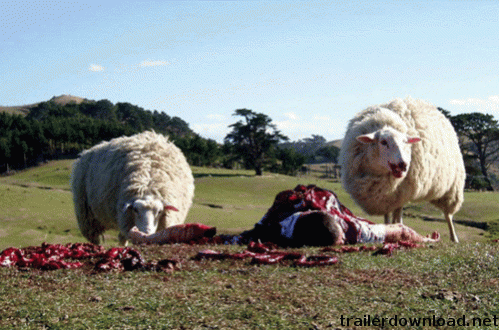
It is safe to say that there is no possible sheep joke that doesn’t find its way in front of the camera in BLACK SHEEP. Mint sauce acts like holy water; an antidote for were-sheep-ism, when discovered, is administered in the form of a drench; and although the human characters are powerless to stop it, a berserk were-sheep is brought to bay by the eye of an ordinary sheep-dog. The film’s idea of what a “genetic engineering lab” might look like is, intentionally or otherwise, simply hilarious, as indeed is the wardrobe of choice of its rogue scientist, Dr Rush, who while occupying a sheep farm in the middle of sunny New Zealand, opts to dress in gleaming white pant-suits and spike heels.
However, probably to no-one’s surprise, the bulk of the non-violent humour in this film is focused upon what we have to call, not just “a” New Zealand sheep joke, but “THE” New Zealand sheep joke – and here, too, the sheep is given the opportunity to revenge itself upon mankind when Henry, somewhat inadequately disguised in a covering of sheepskin car seat covers, attracts the attention of a horny ram. After this, there is a certain inevitability about the revelation of Angus’s relationship with his experimental sheep. But don’t think that BLACK SHEEP has hit the bottom of the barrel just yet – if you’ll excuse the use of the word “bottom” in this context. What would a gross-out comedy be, after all, without fart jokes? And BLACK SHEEP isn’t content just to make a fart joke or two; oh, no; instead, it builds its climactic scene around what might just be the fart joke to end all fart jokes. (Quoth Experience: “Methane….”)
The screenplay is rarely more than adequate. The characters are all stock and, while they’re amusing, they’re also fairly one-note. As with many New Zealand films, BLACK SHEEP evinces a degree of suspicion about anyone or anything that is remotely citified. Thus, while Tucker, the Maori station manager, is largely exempt from criticism, almost everyone else takes a severe pounding. Even Henry, our nominal hero, is rigorously punished for his initial self-absorption. Thankfully, this film refrains from falling into the same trap as one of its obvious models, MAN’S BEST FRIEND. It may be Angus and Dr Rush who have developed the ovine horror, but it is Experience and Grant who let it loose; and the film slaps at both sides of this ethical divide with equal gusto. BLACK SHEEP’s use of its locations is a real strength, highlighting the gorgeous New Zealand landscape without ever feeling like a travelogue. Indeed, in this respect the film deliberately and shrewdly undermines itself: Experience pauses on a cliff edge to admire the stunning view, only to be told that this is where Henry’s father fell to his death.
Screenplay, locations, cinematography – Pah! What we’re here for is the killer sheep, right? The special effects in this film are a bit of a mixed bag. The body-part effects are generally convincing, the sheep themselves somewhat less so – although undoubtedly, a lot of the goofiness is completely intentional. There is some CGI on display here, but its use is limited, mostly confined to some of the human-sheep transformation scenes, and to the stampede sequences. The killer sheep effects are predominantly mechanical, achieved through puppeteering and animatronics, and it is to this that most of this film’s idiotic charm can be credited.
It is clear thatBLACK SHEEP’s writer-director Jonathan King knows and understands his roots. Spiritually – spiritually!? – this film’s main inspiration is the early work of Peter Jackson, those home-made splatter films, BAD TASTE and BRAINDEAD; but numerous other genre films rate a reference, too. We have, for instance, the inevitable NIGHT OF THE LIVING DEAD siege sequence; the best mass-slaughter-of-a-social-gathering since ALLIGATOR; and a transformation scene modelled squarely on the centrepiece of AN AMERICAN WEREWOLF IN LONDON. Alas, BLACK SHEEP’s budget didn’t allow for the full extravaganza, but those jutting sheep’s jaws bring a fond smile to the face, just the same. This is certainly a work intended to appeal to those who know and love their killer animal films; who get a nasty thrill out of watching humankind being done unto as it generally does unto others. It’s not great; it’s not original; and it certainly isn’t art. But then, who wants art all the time? As an hour and a half of dumb, disgusting fun, BLACK SHEEP can’t be bleat (ahem).
BLACK SHEEP (Live Stock Films, 2006). Written and directed by Jonathan King. Cast: Nathan Meister, Danielle Mason, Peter Feeney, Tammy Davis, Glenis Levestam, Tandi Wright, Oliver Driver, Mathew Cahmberlain.
Scaredy Cats: Tales of Terror – "The Black Cat" (1962)
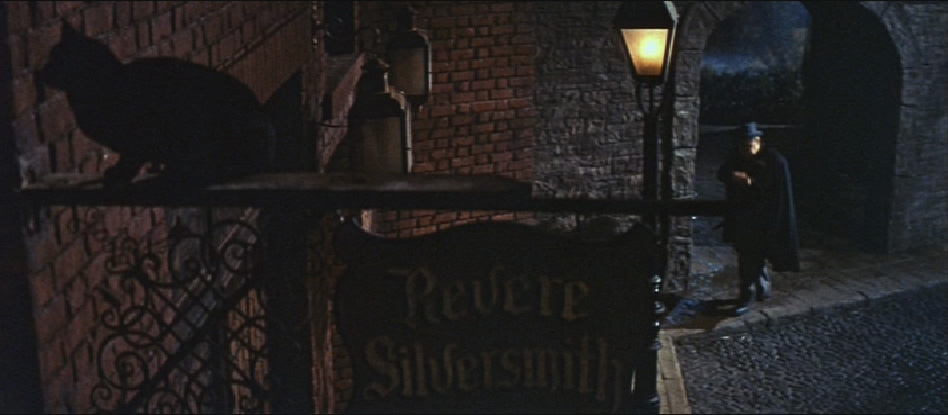
Friday Cat Blogging is an Internet tradition not much associated with cinefantastique, but we are doing our best to change that. Not so long ago, we did an installment dedicated to Stuart Gordon’s MASTERS OF HORROR adaptation of Edgar Allan Poe’s “The Black Cat.” This week, we’re taking a look at producer-director Roger Corman’s TALES OF TERROR, a 1962 anthology film that includes an episode inspired by the very same story.
In Corman’s triptych of tales inspired by Edgar Allan Poe, “The Black Cat” shows up in the middle episode (which includes elements of “The Cask of Amontillado”). Rotund Peter Lorre plays Montresor Herringbone, a jovial alcoholic who introduces his wife to a handsome wine-taster (Vincent Price). When he discovers they are having an affair, he kills them and walls the ir bodies in the cellar but inadvertently entombs the cat as well, its mournful wail alerting the police to the corpses.
To provide a change of pace from the first and third episodes in this anthology film, screenwriter Richard Matheson turned “The Black Cat” into a black comedy and left out the more gruesome elements (in the story, the demented narrator plucks out the cat’s eye and later hangs it to death, only to be horrified when an exact duplicate – down to the rope mark on its neck – arrives to haunt him). The actors do a fine job of playing the horror for laughs, and Lorre is particularly adept at being both funny and menacing, but the title character (first scene atop a sign as Herringbone walks home) is not one of the most memorable screen felines – more innocuous than ominous, it is an object of Herringbone’s hatred more than a symbol of his guilty conscience. Fortunately, the nameless pet (known as Pluto in Poe’s story) does provide a memorable final close-up when discovered on the head of its dead mistress, wailing with rage.
Despite the comedic liberties, the adaptation is closer to Poe than either of the two films that Universal Pictures named after the story (in 1934 and 1941 respectively). One might gripe that Lorre’s Herringbone is a drunken lout from the moment we meet him, so we never see his descent from normalcy, but Corman does capture the essential element: driven by drink, a man brings about his own self-destruction, aided by a cat that – deliberately or accidentally – exacts vengeance for being mistreated. Also noteworthy: scenes of Lorre carousing in bars – and being tossed out for not paying – seem to have inspired similar footage in Stuart Gordon’s more faithful 2006 version.
[serialposts]
Horror Hotel/City of the Dead: Film & DVD Review
 Tonight, as part of their 7th Annual Festival of Fantasy, Horror and Science-Fiction, the American Cinematheque will screen HORROR HOTEL at the Egyptian theatre in Hollywood. This film was known under the somewhat more atmospheric title of CITY OF THE DEAD in its native England (it really should have been called THE THIRTEENTH HOUR, but no one asked me); unfortunately, the Cinematheque seems to be screening the U.S. version, which not only changed the title but also deleted two minutes of footage. Still, any excuse to discuss this excelelnt exercise in atmosphere is good enough for me. It freaked me out when I first saw it as a kid on TV, and subsequent opportunities to enjoy it n the big screen (thanks to previous Cinematheque screenings) have proven that it holds up to adult scrutiny. It may not be a complete masterpiece, but as a cult item it certainly is a gem worth discovering for yourself.
Tonight, as part of their 7th Annual Festival of Fantasy, Horror and Science-Fiction, the American Cinematheque will screen HORROR HOTEL at the Egyptian theatre in Hollywood. This film was known under the somewhat more atmospheric title of CITY OF THE DEAD in its native England (it really should have been called THE THIRTEENTH HOUR, but no one asked me); unfortunately, the Cinematheque seems to be screening the U.S. version, which not only changed the title but also deleted two minutes of footage. Still, any excuse to discuss this excelelnt exercise in atmosphere is good enough for me. It freaked me out when I first saw it as a kid on TV, and subsequent opportunities to enjoy it n the big screen (thanks to previous Cinematheque screenings) have proven that it holds up to adult scrutiny. It may not be a complete masterpiece, but as a cult item it certainly is a gem worth discovering for yourself.
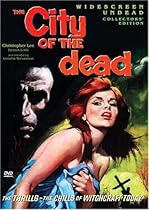 The film — about a New England town ruled by a coven of witches — falls just short of greatness thanks to an excessive reliance on horror movie cliches (e.g., sinister residents of said town staring ominously at the hapless protagonists). Although the lack of subtlety and refinement relegate the film to the ranks of entertaining spook shows (rather than genre classics), the four-star level of weirdness earns HORROR HOTE/CITY OF THE DEAD a place alongside the most memorable horror movies. On top of that, it sports what may be the best, most terrifying (happy) ending ever seen in a genre fear fest – a genuine tour-de-force so powerful in its imagery that it almost single-handedly erases any reservations one has about the rest of the movie.
The film — about a New England town ruled by a coven of witches — falls just short of greatness thanks to an excessive reliance on horror movie cliches (e.g., sinister residents of said town staring ominously at the hapless protagonists). Although the lack of subtlety and refinement relegate the film to the ranks of entertaining spook shows (rather than genre classics), the four-star level of weirdness earns HORROR HOTE/CITY OF THE DEAD a place alongside the most memorable horror movies. On top of that, it sports what may be the best, most terrifying (happy) ending ever seen in a genre fear fest – a genuine tour-de-force so powerful in its imagery that it almost single-handedly erases any reservations one has about the rest of the movie.
Borrowing a page from Mario Bava’s BLACK SUNDAY, the story begins with the execution of a witch, Elizabeth Selwyn (Patricia Jessel), around the time of the Salem Witch trials. Centuries later, Nan Barlow (Venetia Stevenson) is a college student taking a course in witchcraft by Professor Alan Driscoll (Christopher Lee). In order to do some research for a term paper, she takes the professor’s advice and visits a Whitewood, the town where Selwyn was executed, and checks into the Raven’s Inn, which is operated by Mrs. Newless (also Jessel). Shortly thereafter, poor Nan finds herself abducted into the catacombs below the hotel, where she is the victim of a ritual sacrifice; among the hooded faces looming over her are Mrs. Newless and Professor Driscoll. Nan’s brother Richard (Dennis Lotis) and her boyfriend Bill (Tom Naylor) grow worried when she fails to return from Whitewood, so they investigate; Bill gets in an auto accident on the way and remains mostly on the sidelines, while Richard talks with Patricia (Betta St. John), the daughter of the aging local Reverend (Norman Macowan), who claims that Whitewood is under a curse: the executed witch Elizabeth Selwyn now presides over a coven that maintains immortality by performing sacrifices when the clock strikes thirteen. The only way to stop them is with the shadow of the cross. Richard is skeptical until Patricia is abducted to be the next sacrifice; he tries to save her, but the cult members restrain him. Bill revives from his stupor as the clock begins to strike midnight. The cult cannot flee without completing the ritual, and Mrs. Newless cannot strike the lethal blow (with a knife) until the thirteenth tolling. Following shouted orders from Richard, Bill uproots a cross from the graveyard and stumbles weakly toward the scene of the intended sacrifice; as the shadow of the cross falls upon the cult members, they burst into flames. Finally, Bill collapses, dead. Patricia and Richard go searching for Mrs. Newless, who got away. They find her in the hotel, her corpse withered and aged as if she had been dead hundreds of years.
As a piece of storytelling, HORROR HOTEL lifts several obvious motifs from Alfred Hitchcock’s PSYCHO. Most notably, there is the hotel set in an isolated area that is now almost forgotten. The ostensible lead is a young blond woman who is murdered with a knife midway through. And the final revelation of Mrs. Newless in her decomposed state recalls the withered corpse of Norman’s mother in the cellar of the Bates mansion.
Despite the obviously derivative elements, HORROR HOTEL works on its own terms as a sinister piece of supernatural horror. The New England setting, the witchcraft rituals, and the twist with Professor Driscoll being part of the coven — all of these tie in nicely, creating a solid storyline the pulls the viewer along into the movie’s strange world.
And it is strange. HORROR HOTEL is one of those lucky films (“accidental art,” as I like to call it) whose missteps and limitations somehow magically fall into place, creating a weird alternative universe — a sort of Twilight Zone in which the incredible seems completely natural. To begin with, there are no actual exterior location shots anywhere in the movie, which was filmed entirely on studio sets, creating a claustrophobic sense of being cut off from the world at large. The “normal” world of college and homes is depicted only in interiors, mostly brightly lit and cheerful. Whitewood, on the other hand, has numerous “exterior” scenes that were actually filmed inside a sound stage. Filled with fog, this obviously artificial town comes across like something out of a demented dream, the unreality adding to, rather than undermining, the unease in the audience.
The film’s second major lucky break lies in the fact that it is an English production set in New England. The British cast strives with varying degrees of success (Lee best among them) to affect mid-Atlantic accents, and the result is a stilted artificiality that almost makes the film sound dubbed. However, as with the unreal (or surreal) exteriors, the strange vocal inflections only increase the off-balance sense of being set apart from the real world, adding another layer to the perception that we are trapped in a dreamy, imaginary landscape.
Where the film falls short is in knowing when to back off the spook show theatrics. The townsfolk of Whitewood are given to hushed whispers and threatening glances, underlined with lingering tight shots and music meant to instill fear. Not only is this effect so overdone that you are tempted to laugh, there is also a mysterious “Elder” (Fred Johnson), who shows up to hitch a ride with each intended victim, and then inexplicably disappears from the car upon arriving in Whitewood – a piece of hokum that is more amusing that frightening. It’s not bad exactly, but it does seem to scream, “Ooo, scary!” in a manner that recalls SCTV’s Count Floyd.
Whatever the missteps, the film hits its stride during the climax, which is one of the greatest horror sequences ever filmed. The black-and-white photography lends the shadowy images an Expressionist power that goes far beyond anything conjured up by the narrative. Nan’s dying boyfriend Bill, ostensibly the hero, resembles a shuffling zombie, seen only in silhouette as he wields the cross like a child using a magnifying lens to focus the rays of the sun into a flash-point that ignites the target in a burst of flame. There is something uncanny in the character’s movements, as if he were a puppet animated by an external supernatural force (rather like the revived sailors in Coleridge’s “Rhyme of the Ancient Mariner”), and cloaking his face adds to the perception that Bill may already be dead, his body nothing more than a vessel for some kind of divine retribution meted out against Elizabeth Selwyn’s cult. Never has the power of a righteous God been portrayed with such unnerving force; even the plagues visited upon Egypt in THE TEN COMMANDEMENTS seem tame by comparison.
The entire film may not work at this exalted level, but it is more than suspenseful enough to hold your attention until the climax. Although his is truly a supporting role, horror star Lee turns in a solid performance, nicely bridging the gap between stern professor and demented cultist without undue histrionics. Despite the awkward accents, the rest of the cast mostly handle their roles well, even if the villains overdo their spooky routine a bit. The slightly hammy approach to horror during the early sequences guarantees that HORROR HOTEL will never achieve the same high critical reputation as, for example, DIABOLIQUES, but like that much-praised French thriller, HORROR HOTEL saves the best for last, serving up a devastating denouement that induces a level of fear few films ever achieve.
TRIVIA
Although the names “Selwyn” and “Newless” are not anagrams, they are the phonetic equivalent of palindromes (that is, “Selwyn” pronounced backwards sounds like “Newless”), indicating that that the Mrs. Newless who presides over the hotel is indeed the same person as the witch Elizabeth Selwyn, who was executed centuries ago.
This is the first horror film from the producer team of Milton Subotsky and Max J. Rosenberg (although the latter is uncredited). Later, the duo would form Amicus, a film company responsible for numerous horror titles in the 1960s and 1970s, including DR. TERROR’S HOUSE OF HORRORS, TORTURE GARDEN, and THE HOUSE THAT DRIPPED BLOOD.
Director John Llewellyn Moxey later directed 1973’s THE NIGHT STALKER (about a vampire in Las Vegas), which became the most-watched made-for-television movie up to that time.
In one scene, Professor Alan Driscoll (Christopher Lee) is seen sacrificing a small bird in his office; he is almost interrupted by the doorbell, forcing the visibly annoyed professor to put on a happy face and receive an unwanted visitor. The scene seems to have inspired a similar one in Ken Russell’s adaptation of LAIR OF THE WHITE WORM. In the latter film, Amanda Donahoe’s pagan priestess is on the verge of sacrificing a young virgin she has lured to her mansion, when she is interrupted by the doorbell and snarls, “Oh, shit!”
DVD DETAILS
HORROR HOTEL has been released several times on DVD, but the only version currently available is under the title CITY OF THE DEAD. This “Widescreen Undead Collector’s Edition” from VCI offers the original English cut of the film, plus numerous bonus features:
- Audio commentary and interview with star Christopher Lee
- Audio commentary and interview with director John Moxey
- Interview with actress Venetia Stevenson
- Theatrical trailer, photos, and talent bios
The widescreen presentation is clean, clear, and beautiful, especially if you are watching on a 16×9 television. Unfortunately, VCI’s initial pressing of the disc presented problems for regular televisions; it was difficult if not impossible to set the aspect ratio for pan-and-scan or letterbox, so you ended up watching the film squeezed. (Hopefully, the current pressing, which has redesigned cover art [shown below] has fixed this.)
The interview with Christopher Lee is informative, though occasionally marred by the actor’s tendancy to lapse into pompous pronouncements about the state of the British film industry. Lee also trots out his standard complaint about being typecast by the press (who still see him as Dracula over thirty years since he last played th role), but when he gets down to business he actually has a lot to say – about the film and his career in genre pictures. (Most interesting for fans of Lee’s Hammer horror films is his statement that director Terence Fisher ” knew what he want – when he saw it,” meaning that Fisher made the cast rehearse the scene until they showed him something he liked.)
Unfortunately, Lee’s audio commentary suggests that he said everything he had to say during the video interview. Most of his comments consist of describing the action on screen while remarking that he is not quite sure what is happening because he cannot hear the sound. The few bright points occur when he extolls the virtues of the film’s atmospheric black-and-white cinematography and when he briefly mocks his own performance for laying on the sinister angle too thick early on. As if aware of the shortcomings, toward the end he asks, “Do you think people are really going to watch this film, listen to the dialogue, and listen to me? […] I imagine you’ll cut a great deal of what I’m saying.”
Director John Moxey’s interview is also worth checking out. Although not a genre specialist (his only other major genre credit is the tele-film THE NIGHT STALKER), he speaks knowledgeably about the techniques necessary to generate mood and suspense. He seems particularly fond of one technique he used to convey a sense of the uncanny: early in the film, a character walks down the street of the haunted city and sees numerous, ominous townspeople; when another character follows the same path later in the film, we see the same townspeople in pretty much the same order, creating a dream-like feeling of repetition.
Actress Venetia Stevenson’s interview is breezy and fun but less informative; because she was on the film for such a short time, she has less to say about it, focusing instead on the rest of her career (which included a switch to working behind the camera). Trivia buffs, however, will delight in learning that Stevenson’s mother, Anna Lee, co-starred with Boris Karloff in the classic 1945 horror film BEDLAM, before going on to play the role of Lyla Quatermain (named after the hero of KING SOLOMON’S MINES) in a long-running afternoon soap opera.
The so-called “Original American Trailer” looks vintage in terms of the footage, but it has video-generated titles that display the film’s English title CITY OF THE DEAD; there is also a 2001 copyright date, suggesting that this version of the trailer was created for the DVD release. It’s one of those trailers that gives away too much (including the final image), and the melodramatic narration lays things on a bit too thick.
The photo gallery is actually a slideshow containing nearly three dozen images: publicity shots, behind-the-scenes photographs, posters, lobby cards, and home video cover art. Unfortunately, the images are not accompanied by a music cue from the film’s soundtrack.
The talent bios, ccntrary to standard DVD form, are not static; the text scrolls up the frame like the opening crawl in STARS WARS; fortunately, you can use you pause button if you want to peruse the filmographies included at the end of each. The information is thin. In the case of Moxey, Lee, and Stevenson, this hardly matters, since we learn details in their video interviews elsewhere on the disc; however, it would have been nice to include something more substantial about Patricia Jessell, Dennis Lotis, and Betta St. John; otherwise, why bother including them at all? The worst example is for Lotis, who played Richard Barlow, the brother of the missing Nan. His bio reads simply:
In THE CITY OF THE DEAD, Dennis Lotis plays Richard Barlow, the concerned brother of the adventurous Nan Barlow, who has gone ‘missing.’
As if you couldn’t have figured that out from watching the movie!
CITY OF THE DEAD (a.k.a. HORROR HOTEL, 1960). Directed by John Moxey. Written by George Baxt, story by Milton Subotsky. Cast: Christopher Lee, Patricia Jessel, Dennis Lotis, Tom Maylor, Betta St. John, Venetia Stevenson, Valentine Dyall, Ann Beach.
[serialposts]
Sense of Wonder: Genre films keep movie-going alive!
 I’m a little bit old school when it comes to enjoying genre movies: I believe they deserve to be seen on the big screen, where the special visual and sound effects can really blast your senses into another dimension. Yes, I own a big screen TV and a DVD player (and even a laserdisc player for those titles not yet available on DVD), and my computer is set up to download movies from Netflix. Yet, when push comes to shove, I want to go to the theatre to see a film, even if it’s not a great one.
I’m a little bit old school when it comes to enjoying genre movies: I believe they deserve to be seen on the big screen, where the special visual and sound effects can really blast your senses into another dimension. Yes, I own a big screen TV and a DVD player (and even a laserdisc player for those titles not yet available on DVD), and my computer is set up to download movies from Netflix. Yet, when push comes to shove, I want to go to the theatre to see a film, even if it’s not a great one.
Therefore, I was pleasantly surprised to see this column by Peter Part in Variety: “Spree of threes defies doomsayers.” The gist of Bart’s piece is that, two years ago, doomsayers were predicting the death of theatre movie-going, thanks to the disappointing box office results of Summer 2005; however, this year sees ticket sales up 10%, with eleven films earning over $100-million and four passing the $300-million mark. Continue reading “Sense of Wonder: Genre films keep movie-going alive!”
Sense of Wonder: Depp to cast Dark Shadows on the big screen
 DARK SHADOWS fans – at least the ones I know – are rejoicing at the news (announced in Daily Variety and at a recent ShadowCon) that Johnny Depp has signed a deal to co-produce a feature film version of the 1960s Gothic soap opera.
DARK SHADOWS fans – at least the ones I know – are rejoicing at the news (announced in Daily Variety and at a recent ShadowCon) that Johnny Depp has signed a deal to co-produce a feature film version of the 1960s Gothic soap opera.
Warner Bros. is teaming with Depp’s Infinitum-Nihil and Graham King’s GK Films to develop a feature based on the ’60s daytime supernatural sudser…
Depp has said in interviews that he has always been obsessed with “Dark Shadows” and had, as a child, wanted to be Barnabas Collins, the vampire patriarch of the series. The role was originated by Jonathan Frid.
I find my own enthusiasm considerably more muted, although I am willing to be pleasantly surprised. I suspect that, as a property, DARK SHADOWS truly is a relic of its era, and I’m not sure it can be updated without losing its appeal. Not for nothing have forty years of vampire cinema passed since the original show was an afternoon hit, and history provides a couple of reasons to suspect that turning DARK SHADOWS into a feature film and/or updating its story are far from surefire hit ideas. Continue reading “Sense of Wonder: Depp to cast Dark Shadows on the big screen”
The Other Side is the El Mariachi of horror – Film Review
This action-packed horror-thriller combines elements from THE TERMINATOR, THE HIDDEN, and even SUPERMAN II, placing them in a supernatural context and wrapping them up in an intricate plot that weaves together a murder-mystery with a touching love story. Writer-director Gregg Bishop’s action-packed opus – about souls that escape from hell and are tracked down by almost unkillable “Reapers” intent on bringing them back – may be the EL MARIACHI of horror films: a low-budget calling card intended to open doors to Hollywood, allowing for a big-budget sequel-remake down the road.
With its seemingly non-stop action and supernatural thrills, THE OTHER SIDE certainly delivers the goods that will please audiences looking for a rip-roaring good time, but more impressively, the film also tells a complex story without ever dragging the pace to a standstill. The movie begins with Samuel North (Nathan Mobley) returning on a break from college to reuinite with his girlfriend back home. The reunion never takes place, because Sam is murdered, his soul landing in Nether World just long enough to be dragged along on the after-life version of a prison break: he returns from the dead along with a batch of other souls escaping from Hell. With the help of his new comrades, Sam sets out to unravel the mystery of his death, but there’s a big complication: Reapers – a trio of undead hunters whose job is to recapture the souls that belong in Hell.
There is another mystery lurking on the edges of the narrative: Why did Sam, who seems like a nice guy, wind up in Hell when he died? And if Sam truly belongs among the damned, how can the film resolve the love story between him and his girlfriend? Amazingly, instead of glossing over these nagging questions in favor of emphasizing only the action, Bishop’s script addresses them all in turn, tying them together into a tight conclusion that wraps everything up satisfactorily, while still leaving plenty of room for a sequel. In fact, the screenplay is practically a model of efficient story construction; it almost seems designed to prove that gunplay, firepower, and special effects need not be synonymous with brain-dead psuedo-entertainment.
Of course, many a good script and floundered on the shoals of a low budget; fortunately, that is not the case here. The stunning action, stunts, and make-up effects totally belie the financial restrictions of this independently produced film (which was shot in Georgia). But even more impressive is the way the flashy camera work serves the story, deftly juggling the many plot elements without ever dropping the ball.
Bishop pulls off several nice visual touches, not all of them featuring action set pieces. In a nice, sly shot, one of the dangerous Reapers lurks in front of a Neighborhood Watch sign, his upturned collar and furtive movements perfectly matching the iconographic image of the burglar on the sign.
Even better is virtuoso sequence portraying the death and resurrection of one of the Reapers (who take possession of dead bodies in order to do their work on the Earthly plane). When one of the Reapers is run over by a car full of Hell’s escapees, the Reaper’s signature hat falls off his head and rolls away. The camera floats from the body, indicating the soul searching for a new vessel – and alighting upon a passing ambulance, whose doors rip open as the corpse inside burst back to life. Encased in its new body, the Reaper walks by the parking lot where its previous host body died – just in time to grab its hat, which comes rolling down the stairs. The perfection of the timing is laugh-out-loud funny and totally brilliant.
Even without star power, the film features great performances all around, although lead Nathan Mobley is perhaps overshadowed by his supporting players (perhaps because his character is stuck in a situation that he cannot control and is therefore mostly along for the ride). If the film misses perfection anywhere, it is in the resolution of the love story, which relies a bit too heavily on a clichéd happily-ever-after limbo that looks like something out of a perfume commercial. Also, the film never really wrestles addresses the moral question regarding the Reapers: because they are pursuing our protagonist, they come across as the villains; but technically, their job is to retrieve evil souls escaped from Hell, which seems moral and just. Hopefully, the moral implications will be addressed in a sequel.
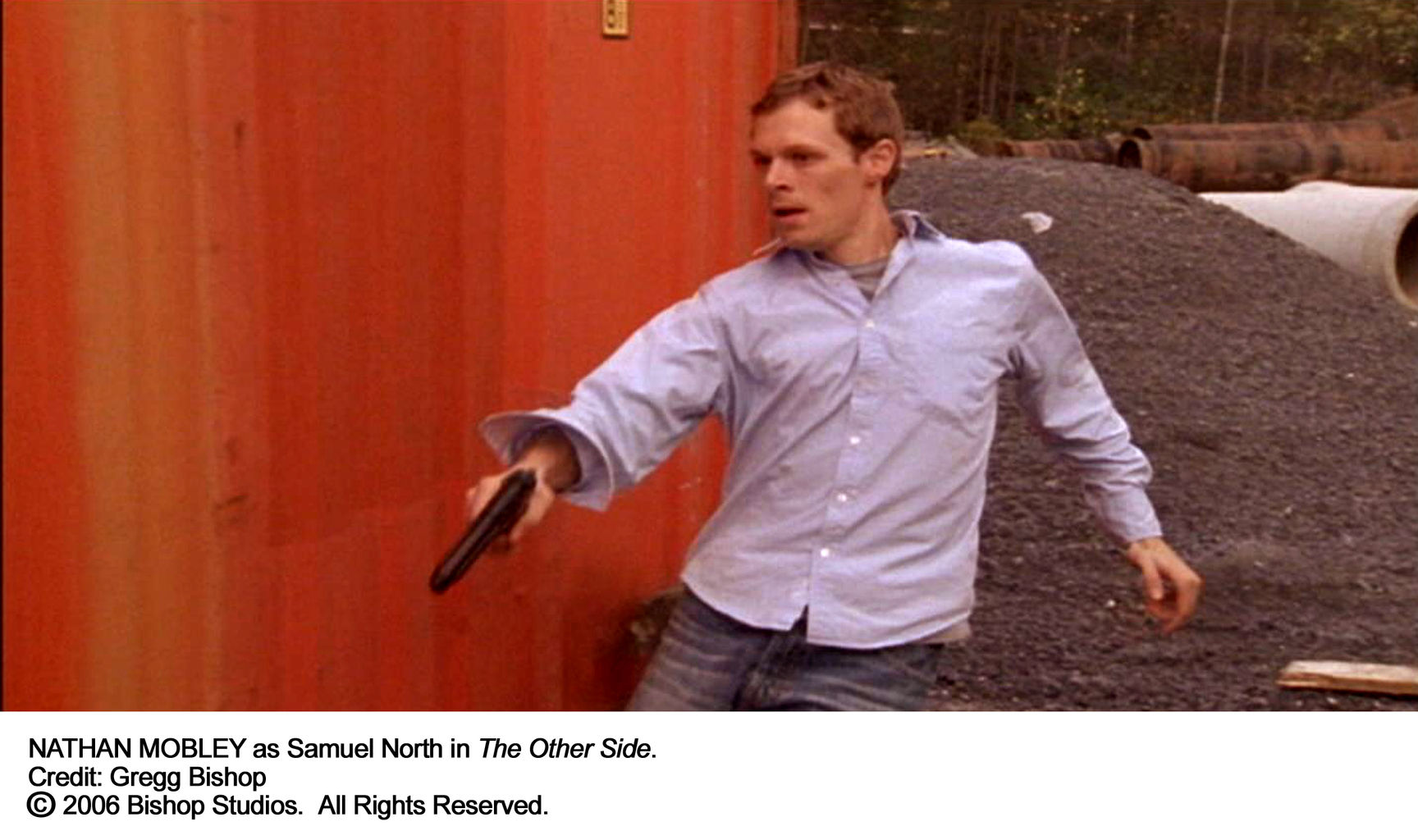
Samuel North (Nathan Mobley) evades the Reapers.
TRIVIA
The film earned a nod for Best Feature film at the 2006 Shriekfest film festival in Hollywood.
The inspiration model for THE OTHER SIDE was Roberto Rodriguez’s EL MARIACHI, a low-budget independent film that launched two slick, big-budget sequels. One of the running gags during the Question-and-Answer session after the screening at Shriekfest was which stars would replace the excellent cast of the original, with names like Ewan MacGregor and Michael Clarke Duncan thrown around.
THE OTHER SIDE (2006). Written and directed by Gregg Bishop. Cast:
Saw IV – Darren Lynn Bousman Interview
Love ‘em or hate ‘em, you have to admit one thing about the SAW franchise: it has managed to avoid the pit that sucks so many horror sequels down into box office oblivion. The first SAW was a sleeper hit, considered a success because its tiny $1-million investment netted nearly $50-million at U.S. theatres; both SAW II and SAW III expanded on that number, each earning over $80-million.
This trajectory is of considerable consequence with SAW IV in the can. Graphic horror is having a rather weak year at the box office, and recent results (the disappointment of GRINDHOUSE, the bomb that was HOSTEL PART II) suggest that splatter appeal no longer draws viewers, who may be turning toward more traditional, spooky horror (witness the relative success of 1408). Despite these ill omens, SAW IV director Darren Lyn Bousman (who has been with the franchise since Part II) thinks he has nothing to worry about. Continue reading “Saw IV – Darren Lynn Bousman Interview”
